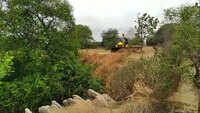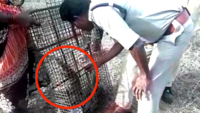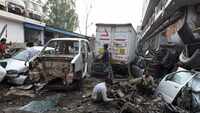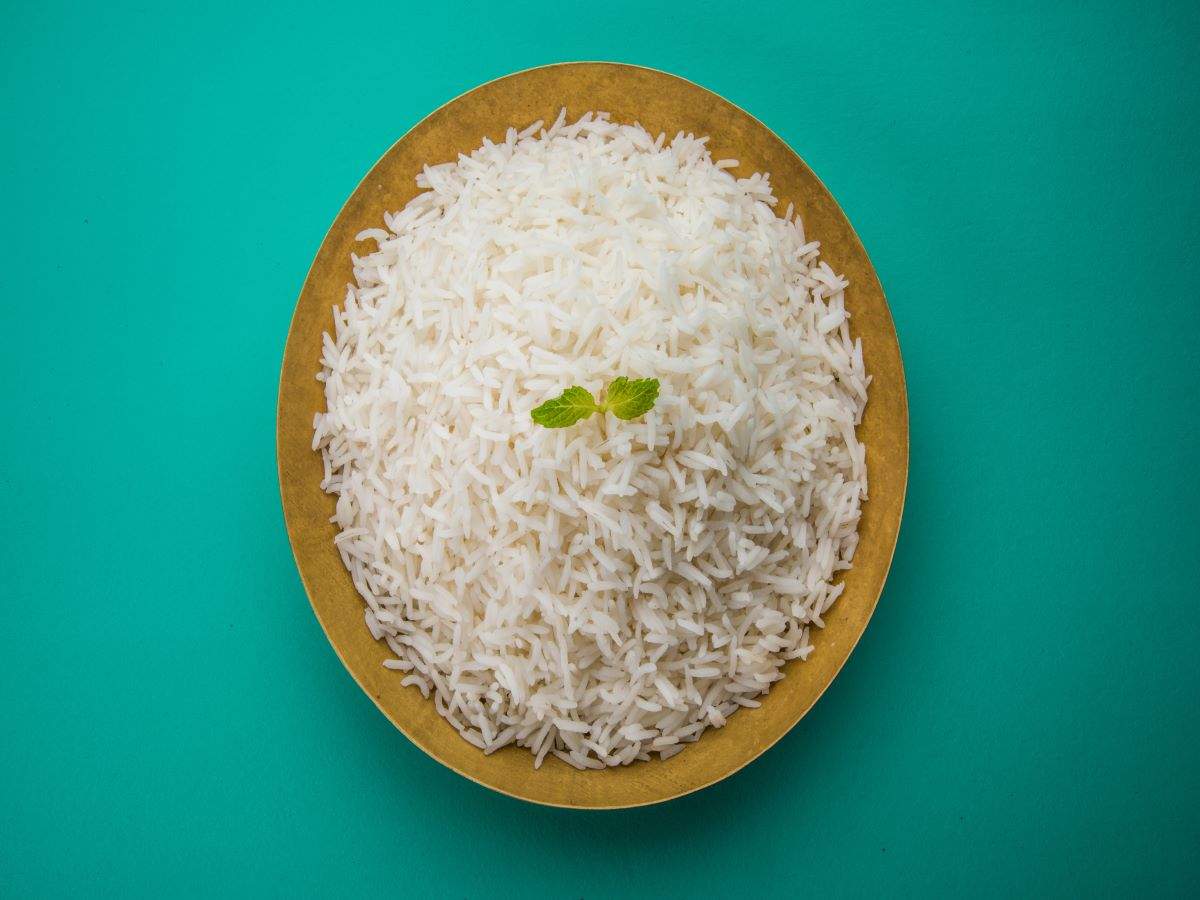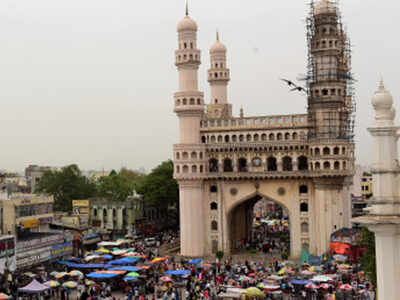
HYDERABAD: Minor damages across the Charminar have kept Archaeological Survey of India officials on their toes. A vertical gap in the pillar of southwest minaret which faces the brunt of weather conditions is among the many repairs being taken up on priority.
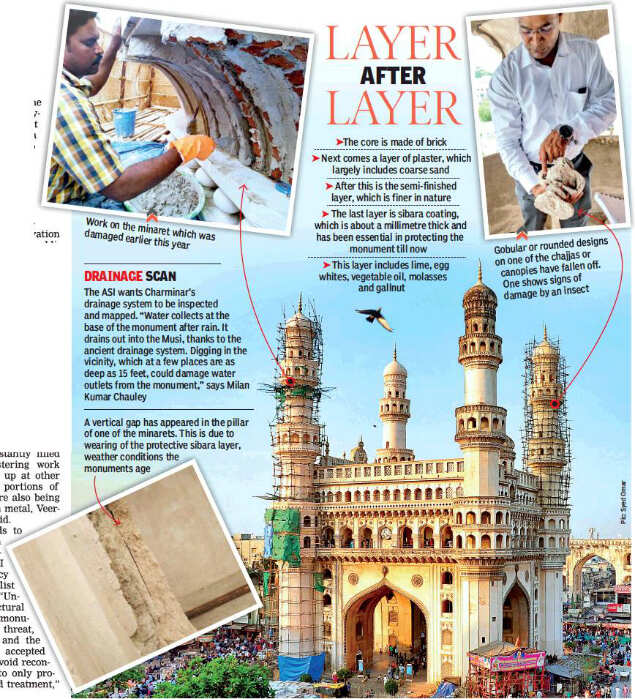
The gap, officials say, has appeared because of a host of reasons including the wearing of the protective millimeter-thick sibara layer, the damage done by weather conditions and pollutants as well as the inevitability of the monuments age.
While inspecting the monument on Tuesday,superintending archaeologist of ASI-Hyderabad, Milan Kumar Chauley, said, “Once the sibara wears off, it exposes the mortar to natural elements. When a gap is created rain and dust further expand this.”
Explaining why the outer layers appear to be crumbling at several places, he said, “With exposure to water, mortar too becomes heavy. The dead mortar loosens and is likely to fall off.”
Veerbhadra Rao, the former head of ASI, Hyderabad, said that light nitric acid which is a result of pollution also destroys the tenacity of plaster, separating it from the core.
A chunk of lime plaster from the minaret fell earlier this year, sparking discussion about the conservation of the monument. In addition to this, loss of stucco work is easily visible at the monument. Globular designs on one of the canopies have fallen off and the intricate jalli work has been damaged at several places. “Besides weather and age,tiny insects that have burrowed into various portions of the monument also contribute to damage,” Chauley said.
ASI officials say that constant minute repairs are being taken up across the monumnet at all times, to ensure its upkeep. As part of repairs, tiny fissures that are noticed are instantly filled up and replastering work is being taken up at other parts. Certain portions of the minarets are also being reinforced with metal, Veerabhadra Rao said.
Workers involved in the process say they can plaster chipped stucco work with cement and not lime that was used originally because the latter takes much longer to set and is tougher to work with - another testimony of the mastery of the original artisans.
With regards to the restoration process, Chauley said that ASI follows a policy of minimalist intervention. “Unless the structural stability of the monument is under threat, ASI guideline and the universally accepted practice is to avoid reconstruction and to only provide specialized treatment,” Chauley said.

The gap, officials say, has appeared because of a host of reasons including the wearing of the protective millimeter-thick sibara layer, the damage done by weather conditions and pollutants as well as the inevitability of the monuments age.
While inspecting the monument on Tuesday,superintending archaeologist of ASI-Hyderabad, Milan Kumar Chauley, said, “Once the sibara wears off, it exposes the mortar to natural elements. When a gap is created rain and dust further expand this.”
Explaining why the outer layers appear to be crumbling at several places, he said, “With exposure to water, mortar too becomes heavy. The dead mortar loosens and is likely to fall off.”
Veerbhadra Rao, the former head of ASI, Hyderabad, said that light nitric acid which is a result of pollution also destroys the tenacity of plaster, separating it from the core.
A chunk of lime plaster from the minaret fell earlier this year, sparking discussion about the conservation of the monument. In addition to this, loss of stucco work is easily visible at the monument. Globular designs on one of the canopies have fallen off and the intricate jalli work has been damaged at several places. “Besides weather and age,tiny insects that have burrowed into various portions of the monument also contribute to damage,” Chauley said.
ASI officials say that constant minute repairs are being taken up across the monumnet at all times, to ensure its upkeep. As part of repairs, tiny fissures that are noticed are instantly filled up and replastering work is being taken up at other parts. Certain portions of the minarets are also being reinforced with metal, Veerabhadra Rao said.
Workers involved in the process say they can plaster chipped stucco work with cement and not lime that was used originally because the latter takes much longer to set and is tougher to work with - another testimony of the mastery of the original artisans.
With regards to the restoration process, Chauley said that ASI follows a policy of minimalist intervention. “Unless the structural stability of the monument is under threat, ASI guideline and the universally accepted practice is to avoid reconstruction and to only provide specialized treatment,” Chauley said.
World Cup 2019
Trending Topics
LATEST VIDEOS
More from TOI
Navbharat Times
Featured Today in Travel
Quick Links
Lok Sabha Election Schedule 2019Lok Sabha Election NewsDelhi Capitals teamMI team 2019Rajasthan Royals 2019RCB team 2019Maharashtra Lok Sabha ConstituenciesBJP Candidate ListBJP List 2019 TamilnaduShiv Sena List 2019AP BJP List 2019Mamata BanerjeeBJP List 2019 MaharashtraPriyanka GandhiBJP List 2019 KarnatakaAMMK Candidate List 2019BJP List 2019 WBLok Sabha Elections in Tamil NaduBSP List 2019 UPNews in TamilLok Sabha Poll 2019Satta Matka 2018PM ModiMahagathbandhanNagpur BJP Candidate ListChandrababu NaiduTamil Nadu ElectionsUrmila MatondkarNews in TeluguMadras High CourtTejashwi YadavArvind KejriwalTejasvi SuryaPawan KalyanArvind KejriwalYogi AdityanathJaya PradaSatta King 2019Srinagar encounter
Get the app
